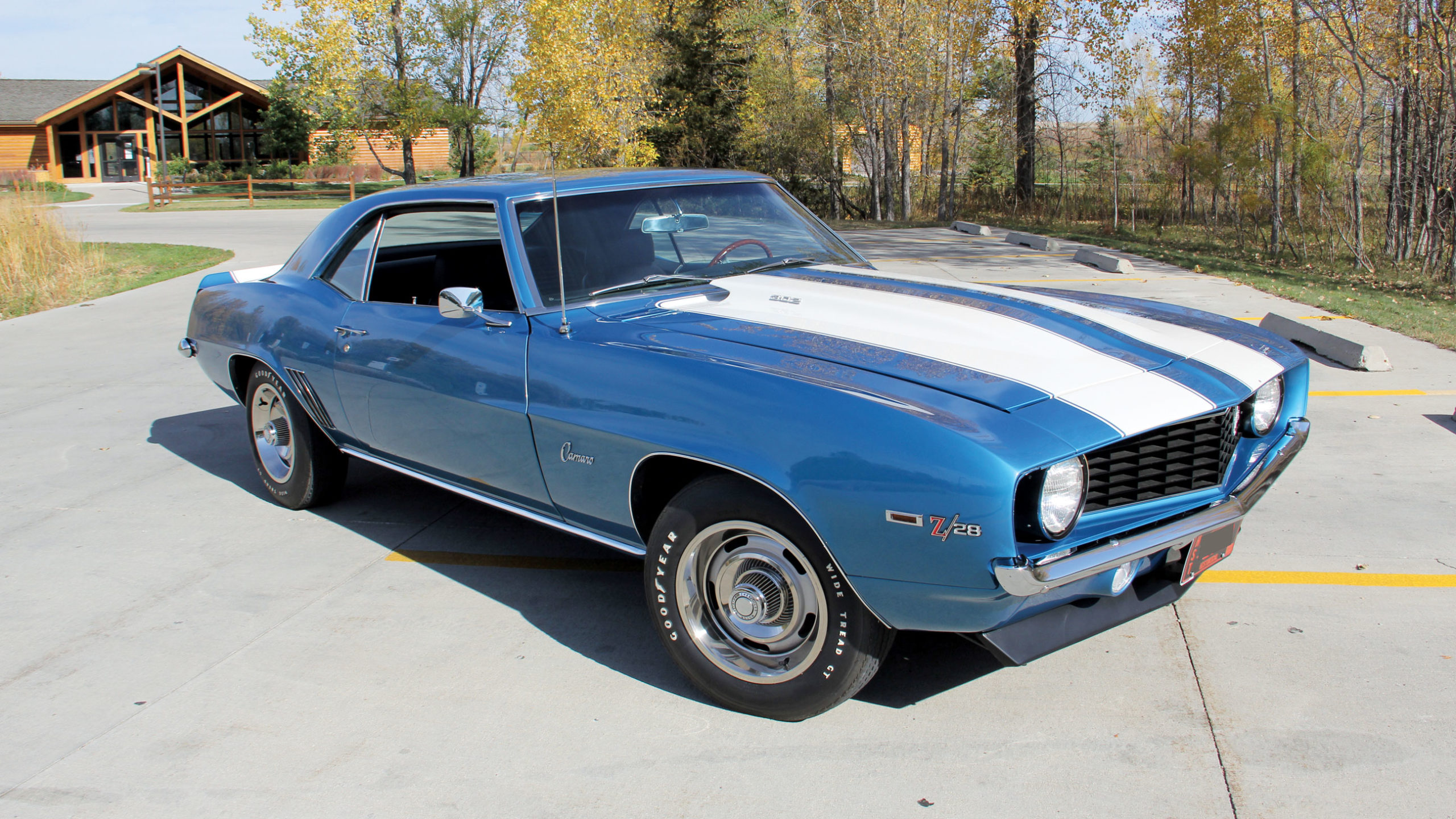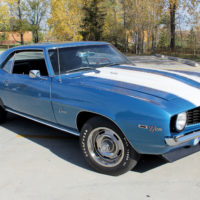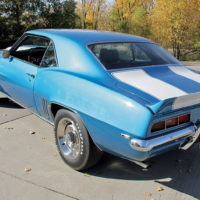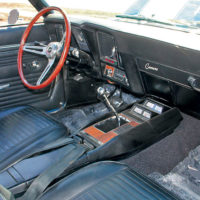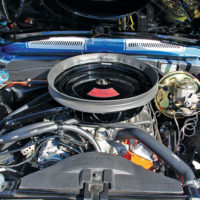- NCRS Shipping Data Report
- No-expense-spared rotisserie restoration by Mike Swedal of Swedal Classic Car Restoration
- Correct 302-ci engine
- Muncie M21 4-speed manual transmission
- 12-bolt 4.10 Positraction rear end
- Cowl induction hood
- Stainless chambered dual exhaust
- X77-D80 coded trim tag
- Factory paint code 71-71 LeMans Blue with white stripes
- Original owner’s manual
SCM Analysis
Detailing
| Vehicle: | 1969 Chevrolet Camaro Z/28 |
| Years Produced: | 1967–69 |
| Number Produced: | 20,302 (1969) |
| SCM Valuation: | $71,500 |
| Tune Up Cost: | $500 |
| Chassis Number Location: | Stamped into instrument panel on driver’s side |
| Club Info: | All-American Camaro & Firebird Association |
| Website: | http://www.allamericancamarofirebird.com |
| Alternatives: | 1969-70 Ford Boss 302 Mustang, 1970 Plymouth AAR ‘Cuda, 1970 AMC Javelin Mark Donohue Edition |
| Investment Grade: | B |
This car, Lot S117, sold for $148,500, including buyer’s premium, at Mecum’s Kansas City sale on December 4, 2021.
When the Camaro arrived for 1967, it was an obvious response to Ford’s Mustang. But Chevrolet did more than just build its own copycat Pony car. With the RPO Z28 option, it offered a “race-ready” performance package.
“Almost!” wrote Car and Driver in 1967. “Inch by cubic inch, Chevrolet warily circles the enthusiast, closing in for the kill. With the Camaro Z/28, they are getting warm — very close to what we’d like to see the Camaro become.”
A year later, the magazine had Sam Posey test a production Z/28 at Lime Rock: “Into the main straight. Shifts to fourth at 7,000 rpm. The speedometer is past 110 mph. On the brakes at the 200-yard marker for The Hook. Down to third. Power on. Sam is sawing away at the wheel and the Camaro is bellowing and squealing and going around The Hook like it was on a tether.”
Car Life explained the appeal of this special Camaro in 1969: “The Z/28’s main attraction is that it’s a race car that doesn’t have to be raced. The excellent handling, the demanding-but-responsive engine, even the distinctive sound, make it a delight to drive, even without the lure of the stoplight Grand Prix.”
Street racer
I contend that no racing series in the 1960s advanced American automotive engineering more than the SCCA’s Trans-Am Championship. Based on the FIA Group 2 Appendix J rules, this highly competitive series was stocked with production-based sedans powered by 5.0-liter (305-cubic-inch) engines. So if Roger Penske wanted four-wheel disc brakes on Mark Donohue’s Camaro, or Bud Moore wanted a larger spoiler and air dam on Parnelli Jones’ Mustang, the manufacturers had to comply with Article 259 of the SCCA Rule Book: “Touring cars shall have been manufactured in a quantity of at least 1,000 units and be equipped with four seats.”
The result was Pony cars in dealer showrooms with high-revving V8s, taut suspension, advanced braking and rudimentary aerodynamics that could perform much like the racers they bred. These were no ordinary Motor City monster-engine muscle machines.
Chevrolet was first with a Trans-Am-compliant street machine, the 1967 Z/28 with a 302-ci V8 and M21 4-speed. Every other Pony car builder eventually followed suit. This makes the first-generation Camaro Z/28 very appealing, especially since the second-generation Z/28 lost much of this racy persona.
Introduced late in the ’67 season (thereby avoiding the 1,000-car rule), just 607 were sold the first year. That small volume alone makes these the most valuable. The following year saw 7,199 produced and that figure exploded in 1969, when 20,302 were built.
Better than many
Mark Donohue, driving Roger Penske’s famous Sunoco Blue Z/28, won the Trans-Am series in 1968 and again in 1969. The growing legend of the Z/28 clearly drove sales.
Yet with so many produced, what separates an exceptional Z/28 from the rest today? Our subject car is a perfect example, boasting documentation, originality and desirable options.
Documentation from the National Corvette Restorers Society (yes, they have Camaro and other Chevy data too) not only proves this is a true Z/28, but that it was sold new by Humphrey Chevrolet in my hometown of Milwaukee, WI. Humphrey is long gone, but I remember it being one of two or three dealers in town that understood performance cars, even selling Yenkos.
As for originality, this car’s restorer, Mike Swedal, has been restoring Camaros at his Minnesota shop since he was 14, when he began learning the craft from his dad. “My first car was a ’68 Camaro,” he told me. “I think the Z/28 is the thirty-sixth Camaro I’ve restored. This car spent its whole life in Wisconsin, and I restored it with all OEM components wherever possible. I restore all makes, but Camaros are my favorite.”
Documented options include the performance ZL2 Cowl Induction hood and NC8 dual-chambered exhaust system. It has some comfort items, like the full-length console and tilting steering column with rosewood wheel, but isn’t loaded like the Rally Sport package Z/28s. (To me this just seems wrong for a performance machine.) Code 71 Le Mans Blue paint with white stripes and black vinyl interior seal the deal. If anything is missing from this Camaro, it’s validation of the vehicle’s restoration, say, from Bloomington Gold (it began certifying Camaros just last year) or the Muscle Car and Corvette Nationals.
Worth every penny
Prices for the 1969 Z/28 peaked in the 2000s, with the sale of “Mr. October” Reggie Jackson’s one-of-a-kind Smokey Yunick-built prototype at $283,000. A few other Z/28s sold above $200k, too, but sanity has prevailed since the Great Recession. The SCM Pocket Price Guide shows the current median price at $71,500.
Median, of course, is average, and there is nothing average about this Camaro. A price that’s more than double book value and near the top of post-recession prices makes this very well sold, but I feel it’s worth every penny. In true first-gen Z/28 fashion, everyone’s a winner here. ♦
